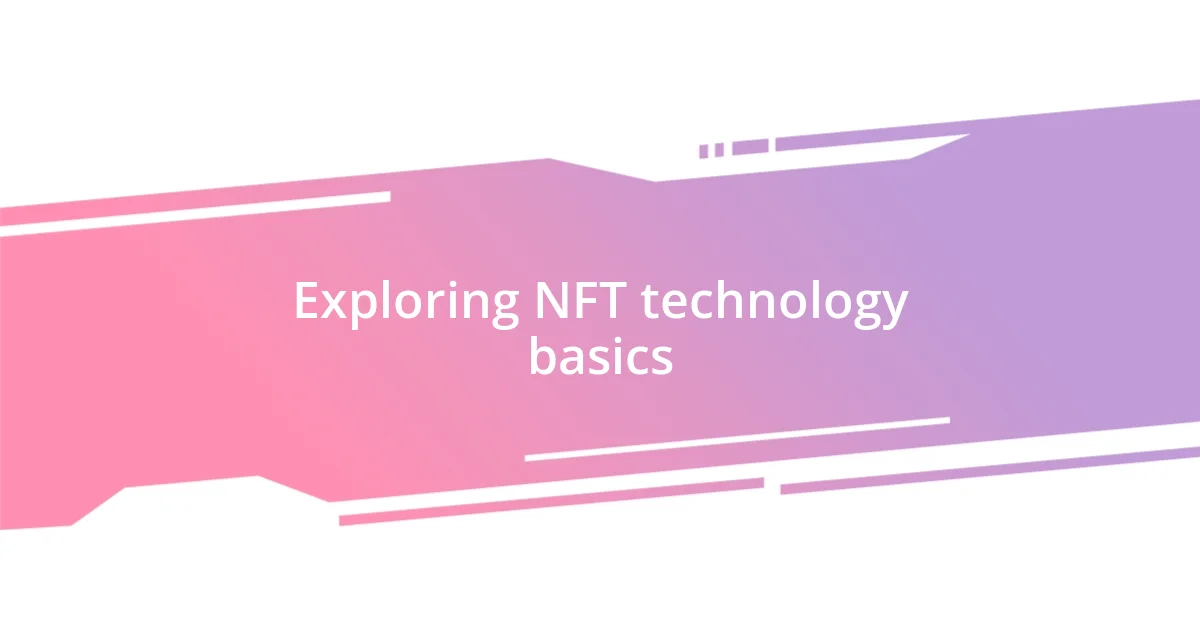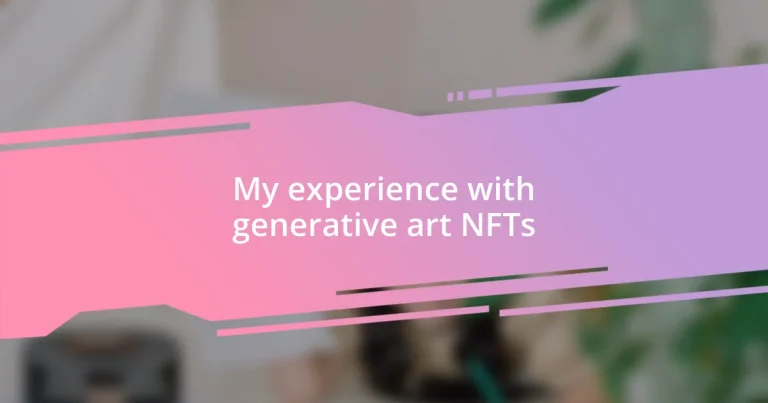Key takeaways:
- Generative art NFTs blend creativity and technology, allowing for unique expressions of art derived from algorithmic processes.
- Building a supportive community is crucial; engaging with fellow creators and sharing experiences fosters collaboration and innovation.
- Timing, storytelling, and overcoming technical challenges are vital in successfully navigating the NFT space and enhancing the impact of one’s art.

Understanding generative art NFTs
Generative art NFTs represent a fascinating blend of creativity and technology. I remember the first time I stumbled upon a digital piece created algorithmically—it felt surreal. How could lines of code transform into something so visually stunning and thought-provoking?
The beauty of generative art lies in its unique ability to produce endless variations from defined parameters, making each NFT distinct. I often find myself reflecting on the idea that no two pieces are the same, even if they emerge from the same underlying code. Isn’t it intriguing to think that art can be both a product of human creativity and mathematical precision?
As I delved deeper into this niche, I realized that purchasing a generative art NFT was more than just acquiring a piece of art; it was about owning a slice of innovation. I vividly recall the thrill of bidding on my first generative NFT, feeling the rush of excitement and anticipation as the countdown ticked away. It challenged my perception of ownership, turning every transaction into a connection with both the creator and the community surrounding this vibrant art form.

My journey into generative art
My journey into generative art began with an unexpected invitation to an online exhibit. I remember staying up late, my laptop glowing in the dark, captivated by the dynamic visuals that morphed and changed before my eyes. My heart raced as I witnessed how code could craft beauty and emotion, offering me a new perspective on both art and technology. The immersive experience felt like stepping into a new dimension of creativity.
Taking those first steps into the generative art community was exhilarating yet daunting. The moment I created my first piece, I felt a surge of pride mixed with uncertainty. Admittedly, I feared my work wouldn’t measure up to the incredible pieces I had seen. But sharing it and receiving feedback from fellow creators reinforced my belief that generative art thrives on collaboration and community—a factor that deepens my passion each day.
As I expanded my knowledge, I found myself drawn to various artists whose styles resonated with my own. Each new piece I encountered was a reminder that generative art isn’t just about the visuals; it’s about exploring ideas and sparking conversations. I often think about the profound connections formed through this art, uniting people from all walks of life. It has transformed my perception of creativity, allowing me to embrace the unpredictable nature of art while celebrating the unique voices within our growing community.
| Aspect | Details |
|---|---|
| Initial Encounter | Online exhibit showcasing dynamic visuals |
| Emotional Response | Excitement and awe at the blend of code and creativity |
| Community Impact | Support and feedback foster a sense of belonging |
| Artistic Growth | Connecting with various artists inspires exploration |

Exploring NFT technology basics
When I first encountered NFTs, the concepts felt overwhelmingly complex yet exhilarating. I remember the moment vividly; it was a late-night deep dive into blockchain technology, trying to wrap my head around how digital assets could hold value. The idea that each NFT is a unique token, securely stored on the blockchain, resonated with me. I soon realized that this technology allows artists to authenticate their work and connect directly with fans, creating a new form of ownership in the digital realm.
- Blockchain Technology: A decentralized ledger ensuring transparency and security.
- Uniqueness: Each NFT has a distinct value, which makes it impossible to replicate.
- Ownership Rights: NFT holders own the original work, even if copies exist elsewhere.
- Smart Contracts: Self-executing contracts that automate transactions and royalties.
Diving into this innovative world became a catalyst for my creativity. The first time I minted my own NFT, I felt a blend of pride and nervousness. I was anxious about how the community would react but equally thrilled by the possibilities that lay ahead. This journey has shown me that beyond the tech jargon and speculative market, NFTs represent a shift towards empowering artists and fostering creative expression in ways I’d never imagined.

Creating my first generative art
Creating my first generative art piece was like setting off on an adventure into the unknown. I remember sitting at my desk, staring at a blank canvas on my screen, filled with both excitement and a hint of fear. The thought crossed my mind: “What if I mess it all up?” But then, with a few lines of code, vibrant colors began to emerge, swirling together in unexpected ways. I felt a thrill like I hadn’t experienced in a long time; it was as if I had unlocked a secret door to a realm where my imagination could run wild.
As I dove deeper into the creative process, I realized that generative art wasn’t just about aesthetics—it was a dialogue between me and the algorithms. I often experimented with randomization in my code, and I found myself giggling at the bizarre yet beautiful patterns that emerged. Did I truly have control over my creation, or was it the algorithm leading the dance? This question haunted me and enriched my experience, ultimately spurring me on to embrace the unpredictability that generative art offers.
After a few late-night coding sessions and countless iterations, I completed my first piece. The rush of clicking that ‘export’ button was electrifying; it felt like a digital birth! I shared it on social media, and the feedback from my friends was incredibly encouraging. Some called it “bold,” others “captivating,” and those words resonated deep within me. It dawned on me that creating generative art was more than a solitary endeavor—it sparked a connection with others, reminding me why I fell in love with art in the first place.

Platforms for selling art NFTs
One of the challenges I faced while selling my art NFTs was choosing the right platform. I started by exploring popular options like OpenSea and Rarible, both of which offer user-friendly interfaces and a vast audience. OpenSea stood out to me because it was like walking into a bustling art gallery, filled with creators from around the globe. It was exhilarating to think about my artwork being displayed alongside some incredible digital pieces.
I also delved into more niche platforms, such as Foundation, which seemed to cater to a more curated selection of artists. The application process felt almost like being accepted into an elite club, which gave me a sense of purpose. I remember feeling both anxious and hopeful, waiting for a response on my submission. When I was finally accepted, it felt like validation, and I couldn’t wait to share my work with a community that values artistic integrity.
Each platform has its own unique vibe, and that’s something to consider when selling your own art NFTs. For example, I learned that platforms like Mintable cater to beginners, allowing for a no-code approach to minting art. There’s something empowering about taking that first step with an accessible option. Have you ever felt the rush of sharing something you created with the world? That emotion can drive your choice of platform and ultimately shape your success in this vibrant digital art marketplace.

Building a community around NFTs
Building a community around NFTs has been one of the most rewarding aspects of my journey. I remember the first time I engaged with fellow creators online. We shared tips, celebrated each other’s successes, and formed a bond that felt palpable—even across screens. It made me realize that this space is not just about individual expression; it’s about collective growth and support. Have you ever experienced that feeling of belonging in a virtual world? It’s exhilarating to connect with people who share your passions.
As I started to participate in Discord servers dedicated to generative art, I saw how sharing ideas and techniques could spark inspiration. One memorable discussion involved experimenting with different algorithms—everyone was excited to contribute their own discoveries. This exchange illuminated the power of community. It’s fascinating how collaboration can lead to innovation, pushing boundaries that I hadn’t even considered before. Connecting with other artists not only fuels creativity but also creates a safety net to catch you if you stumble.
Moreover, establishing a presence on social media for my NFTs became crucial. The more I engaged with my audience, the more aware I became of their perspectives. I vividly recall one instance where a follower expressed how my work resonated with them on a personal level. That moment was profound. It was a reminder that art exists in a cyclical relationship with its audience. Strengthening connections with a community brings deeper meaning to our creations, transforming them into shared experiences that resonate far beyond our individual artistic journeys.

Lessons learned from my experience
In my experience, timing is everything when it comes to releasing art NFTs. I remember one day when I decided to drop a new piece just as an influential figure in the NFT space was also launching something. It felt like I was trying to shout over a symphony. That taught me the importance of staying informed about market trends and aligning my releases for maximum visibility. Have you ever felt overshadowed when the timing just wasn’t right? It’s a lesson I won’t forget.
Another critical lesson was the value of storytelling behind each piece. I learned that sharing the inspiration or process behind my generative art can significantly deepen its impact. Once, I wrote a heartfelt post about the emotions I poured into a particular work, and the response was overwhelmingly positive. Folks reached out to share how they connected with my journey; it transformed my art from a simple image into a shared narrative. Have you thought about how your own stories might resonate with others? You might be surprised by the connections you can forge.
Lastly, navigating the technical aspects of NFTs can feel daunting at first, but it’s essential. I vividly recall how I struggled to set up a digital wallet—every error felt like a setback that could ruin my enthusiasm. Overcoming that frustration sparked a new sense of empowerment. Now, I see learning these technical skills as an avenue for creative freedom rather than a chore. Isn’t it amazing how conquering challenges can lead to personal growth? It makes the entire process feel more rewarding and multifaceted, both for the artist and the audience.














